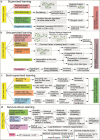Graph- and rule-based learning algorithms: a comprehensive review of their applications for cancer type classification and prognosis using genomic data
- PMID: 30649169
- PMCID: PMC7373185
- DOI: 10.1093/bib/bby120
Graph- and rule-based learning algorithms: a comprehensive review of their applications for cancer type classification and prognosis using genomic data
Abstract
Cancer is well recognized as a complex disease with dysregulated molecular networks or modules. Graph- and rule-based analytics have been applied extensively for cancer classification as well as prognosis using large genomic and other data over the past decade. This article provides a comprehensive review of various graph- and rule-based machine learning algorithms that have been applied to numerous genomics data to determine the cancer-specific gene modules, identify gene signature-based classifiers and carry out other related objectives of potential therapeutic value. This review focuses mainly on the methodological design and features of these algorithms to facilitate the application of these graph- and rule-based analytical approaches for cancer classification and prognosis. Based on the type of data integration, we divided all the algorithms into three categories: model-based integration, pre-processing integration and post-processing integration. Each category is further divided into four sub-categories (supervised, unsupervised, semi-supervised and survival-driven learning analyses) based on learning style. Therefore, a total of 11 categories of methods are summarized with their inputs, objectives and description, advantages and potential limitations. Next, we briefly demonstrate well-known and most recently developed algorithms for each sub-category along with salient information, such as data profiles, statistical or feature selection methods and outputs. Finally, we summarize the appropriate use and efficiency of all categories of graph- and rule mining-based learning methods when input data and specific objective are given. This review aims to help readers to select and use the appropriate algorithms for cancer classification and prognosis study.
Keywords: association rule mining; cancer classification; cancer prognosis; data set integration; gene signature; graph mining; learning technique.
© The Author(s) 2019. Published by Oxford University Press. All rights reserved. For Permissions, please email: journals.permissions@oup.com.
Figures


Similar articles
-
Graph-based semi-supervised learning with genomic data integration using condition-responsive genes applied to phenotype classification.J Am Med Inform Assoc. 2018 Jan 1;25(1):99-108. doi: 10.1093/jamia/ocx032. J Am Med Inform Assoc. 2018. PMID: 28505320 Free PMC article.
-
Supervised, Unsupervised, and Semi-Supervised Feature Selection: A Review on Gene Selection.IEEE/ACM Trans Comput Biol Bioinform. 2016 Sep-Oct;13(5):971-989. doi: 10.1109/TCBB.2015.2478454. Epub 2015 Sep 14. IEEE/ACM Trans Comput Biol Bioinform. 2016. PMID: 26390495
-
CARSVM: a class association rule-based classification framework and its application to gene expression data.Artif Intell Med. 2008 Sep;44(1):7-25. doi: 10.1016/j.artmed.2008.05.002. Epub 2008 Jun 30. Artif Intell Med. 2008. PMID: 18586476
-
A Comprehensive Survey on Graph Neural Networks.IEEE Trans Neural Netw Learn Syst. 2021 Jan;32(1):4-24. doi: 10.1109/TNNLS.2020.2978386. Epub 2021 Jan 4. IEEE Trans Neural Netw Learn Syst. 2021. PMID: 32217482 Review.
-
LEMRG: Decision Rule Generation Algorithm for Mining MicroRNA Expression Data.Adv Exp Med Biol. 2017;1028:105-137. doi: 10.1007/978-981-10-6041-0_7. Adv Exp Med Biol. 2017. PMID: 29058219 Review.
Cited by
-
Multi-Objective Optimized Fuzzy Clustering for Detecting Cell Clusters from Single-Cell Expression Profiles.Genes (Basel). 2019 Aug 13;10(8):611. doi: 10.3390/genes10080611. Genes (Basel). 2019. PMID: 31412637 Free PMC article.
-
Computational Methods Summarizing Mutational Patterns in Cancer: Promise and Limitations for Clinical Applications.Cancers (Basel). 2023 Mar 24;15(7):1958. doi: 10.3390/cancers15071958. Cancers (Basel). 2023. PMID: 37046619 Free PMC article. Review.
-
FokI vitamin D receptor gene polymorphism and serum 25-hydroxyvitamin D in patients with cardiovascular risk.Arch Med Sci Atheroscler Dis. 2019 Dec 31;4:e298-e303. doi: 10.5114/amsad.2019.91437. eCollection 2019. Arch Med Sci Atheroscler Dis. 2019. PMID: 32368685 Free PMC article.
-
Nextcast: A software suite to analyse and model toxicogenomics data.Comput Struct Biotechnol J. 2022 Mar 18;20:1413-1426. doi: 10.1016/j.csbj.2022.03.014. eCollection 2022. Comput Struct Biotechnol J. 2022. PMID: 35386103 Free PMC article.
-
Computational Analysis of High-Dimensional DNA Methylation Data for Cancer Prognosis.J Comput Biol. 2022 Aug;29(8):769-781. doi: 10.1089/cmb.2022.0002. Epub 2022 Jun 6. J Comput Biol. 2022. PMID: 35671506 Free PMC article. Review.
References
-
- Kim M, Tagkopoulos I. Data integration and predictive modeling methods for multi-omics datasets. Mol Omics 2018;14:8–25. - PubMed
Publication types
MeSH terms
Grants and funding
LinkOut - more resources
Full Text Sources
Medical
Miscellaneous

